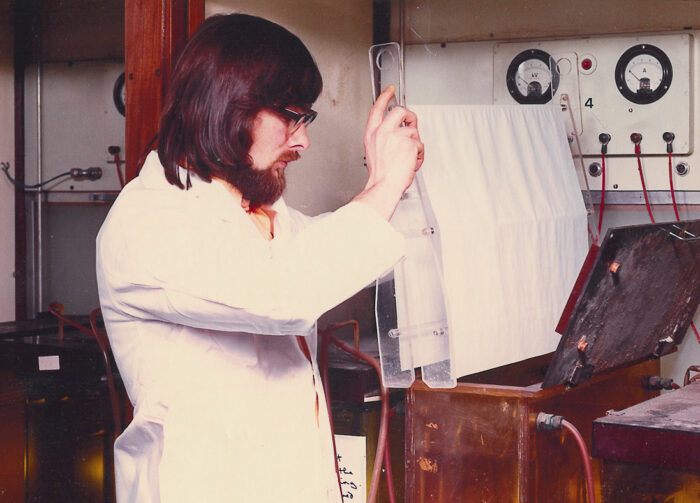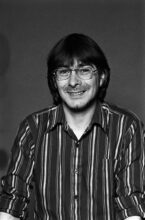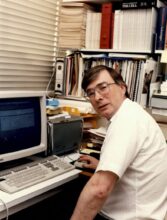
Barclay (Bart) Barrell, former Group Leader in the LMB’s PNAC Division, died recently. Bart spent 30 years at the LMB, where he became internationally recognised as a leader in the field of nucleic acid sequencing and genome analysis. He worked closely with Fred Sanger throughout his time at the LMB, and helped develop new methods for genomic analysis – applying these to increasingly complex models. Amongst several notable breakthroughs, he helped recognise ‘overlapping’ genes in the sequence of bacteriophage ΦX174 and the altered genetic code of mitochondria. These findings specifically proved key to the widening field of genomics.
Bart was born in Breadstone, Gloucestershire in 1944. He attended Dursley Grammar School and, following his keen interest in natural history, specialised in Biology and Chemistry for his final years of education. His passion for molecular biology was sparked after reading about the LMB’s Nobel Prizes; the 1958 Chemistry Prize to Fred Sanger for sequencing amino acids in insulin, the 1962 Physiology or Medicine Prize to Francis Crick, James Watson and Maurice Wilkins for determining the structure of DNA, and the 1962 Chemistry Prize to Max Perutz and John Kendrew for their studies on the structures of myoglobin and haemoglobin. Keen to start work in a laboratory, Bart came to Cambridge in 1963, aged 19, for a position in the newly opened LMB building as a Junior Technical Officer working as Fred Sanger’s personal assistant.

At this time, Fred was beginning his work on nucleic acid sequencing, and Bart quickly became an expert in sequencing and analysis – knowledge he was happy to share with visitors to the LMB. He helped to develop new sequencing techniques and applied these first to tRNA and later to the bacteriophage R17.
Commenting on his arrival at the LMB, Fred Sanger wrote, “He quickly showed outstanding ability, both as an experimentalist and in designing his own experiments.” (Letter from Fred Sanger, July 1977, Biographical File, LMB Archive).
Following advice from Fred, Bart enrolled as a Ph.D. student at King’s College, University of Cambridge in 1974. His scientific reputation was such that the University were happy to accept him without a prior undergraduate degree. He received his Ph.D. in 1977 for studies on the DNA sequence of the bacteriophage ΦX174, using a new ‘plus and minus’ method which he helped develop. Aside from determining the sequence of a large section of the genome, his notable discovery was the finding that one region of DNA utilised two different reading frames to encode two distinct proteins.
From March 1978, Bart held a permanent position as a member of Scientific Staff at the LMB and led various research projects, initially working on human mitochondrial DNA with Alan Bankier and Jacques Drouin. As part of a project to fully sequence mitochondrial DNA (which contains 16,569 base pairs), he helped affirm the idea that the genetic code was not universal after noticing that mitochondria used different codon signals, building on preceding phage genetic mapping experiments by Gillian Air, Denis Shaw and John Walker.

He continued to work closely with Fred, and helped to establish the ‘shotgun’ sequencing strategy. This proved useful for his next ambitious project to sequence the Epstein-Barr virus (EBV) genome – the largest DNA sequence to be completed at the time of its publication in 1984 with 172,282 bases. On top of the ‘shotgun’ approach, the project also required development of new methods, including sonication procedures, buffer gradient gels and a number of manipulation procedures. For the remainder of his time at the LMB, Bart continued to develop manual shotgun sequencing technology, and proved its application by determining the sequence of human cytomegalovirus (c.230,000 base pairs).
He was elected to EMBO in 1986 in recognition of his contribution to genome sequence analysis.
Away from the bench, Bart was an active member of the LMB’s Cricket and Darts teams.
Bart left the LMB in 1993, going on to help found the Wellcome Sanger Centre alongside John Sulston, Jane Rogers, Richard Durbin, David Bentley and Alan Coulson. Here he made significant contributions to the mapping of the yeast genome as Head of Yeast Genetics until 1993, and then served as Head of the Pathogen Sequencing Unit (PSU) until 2005. Before retiring, he returned to the bench, analysing genomes, largely by manual annotation, as he first learnt to when he arrived at the LMB in 1963.
Bart’s funeral service will be held at St. James’ Church, Sewards End at 11AM on Friday 15th December (please contact Daniel Barrell if you wish to attend). In lieu of flowers, donations are requested to Motor Neurone Disease Association and Addenbrooke’s Charitable Trust either via the Peasgood & Skeates website or sent care of Peasgood & Skeates, Shire Hill, Saffron Walden, CB11 3AQ.